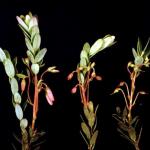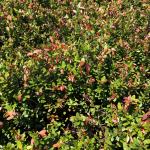We had one report last week of what we believe is Funky Flower. The pathogen is unknown but thought to possibly be a soymovirus. The flowers are distorted, usually a vibrant pink color; it causes vegetative overgrowth (see photos). There are no recommendations for control at this point. If you see symptoms like this on your bog, please let us know (x21 or x18).
Erika from Ocean Spray reports (and we agree) that bloom is moving fast and furious. She is seeing close to 80-90% OOB in newer hybrids and BLs. Weakened areas, due to phytophthora or any other root issues, are hurting (discolored uprights) from this heat wave. While the super hybrids are wrapping up bloom, Stevens and natives seem not to be moving as fast. Many are only now approaching 50% out of bloom. This is when Altacor should go on (after the rains) and targets the fruitworm eggs as they are hatching, with residues lasting 7-10 days. A good NIS should be added.
Monika Shuler reports Spag counts in traps are very high - consider treating both spag and cranberry fruitworm if possible (Altacor will cover both, but if spag very high, an Intrepid/Invertid or a Delegate should be added after the 2 Altacors). Also picking up summer weevils… nothing exceeding threshold but likely will be next week.
Using traps: when treating summer generation of BHF with Altacor, Intrepid or Confirm, apply insecticide 2 weeks after the ONSET of flight (probably right about now) and again 10 days later. If using Delegate or Diazinon should only be used after bloom is over. For Spag, if using Altacor, Intrepid or Confirm, apply insecticide 3 weeks after flight begins (late June) and again 10-14 days later. If using Delegate, timing is 10-14 days AFTER PEAK flight. For girdler, sanding, nematodes and fall floods are recommended. Any questions, call Marty 508-265-6921.
Early fruit set fertilizers go out at 75% bloom; most varieties should be ready. The super hybrids get their second dose at first fruit set, followed by 2 more doses at 7-day intervals.
You need to wait at least 14 days between Callisto applications; only 2 applications allowed per season. For grass herbicides, the label does not restrict spray intervals, but it’s best to wait to see if you get any activity before applying again (suggest at least 2 weeks). The spray interval for QuinStar is 30 days. Be careful during time of high temperatures and humidity for making herbicide applications. If you add the value of the T and the value of the RH and it exceeds 150, the risk of injury is high. Be careful with the adjuvants that you add to your POST herbicides. Crop oil concentrate is much more likely to cause injury during bloom and on hot days than NIS. Any questions, call Hilary or Katie (x21 and 43).
2 more casebearer infestations found this week in Rochester. Remarkably damaging for such a small insect (see pic for size ~ smaller than a pinhead!). Don't be fooled, these dead tips (in pic) are the result of casebearer. If you sweep thru the damage areas, or better yet, the areas around the damaged areas, you should see the tiny beetles on the sides of the sweep net
There has been much discussion of mixing your fungicide with Altacor. We believe it is safe. Many growers have done it already. A report of QuadrisTop/Altacor/NIS with hard to remove residue in tank mix came in. We pulled the NIS out of our spray, and it was fine.
While many of you are up for "audit" this year on your pesticide certification, the July 1 deadline only refers to the time to which you can accrue credits. Credit paperwork does not need to be uploaded immediately, it only needs to be uploaded when you are ready to renew your license in October or November. Marty will be glad to help when that time comes!
Healthy upright on left, funky flowers middle, right (F Caruso)
Vegetative overgrowth from funky flower (P Oudemans)
Casebearer injury 1 and 2



